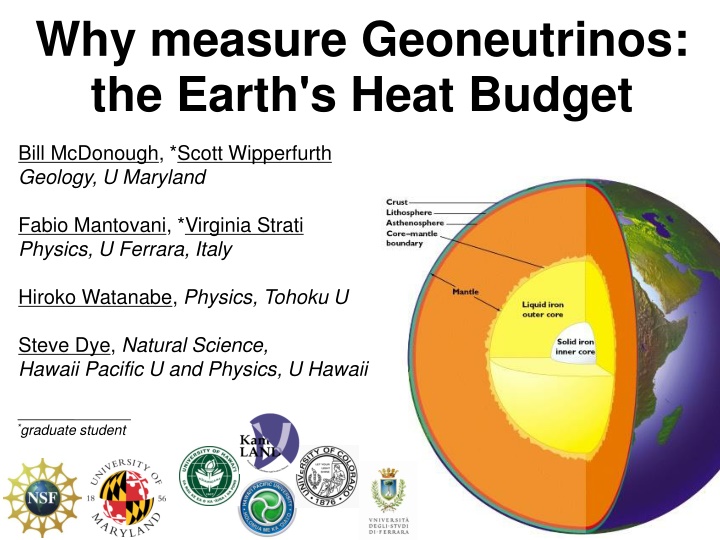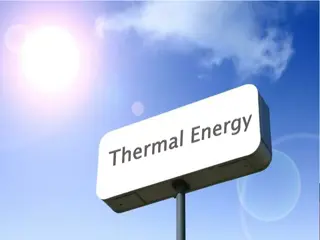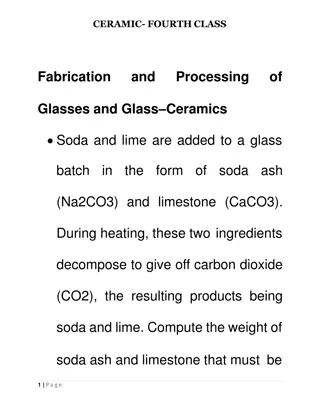Geoneutrinos and Earth's Thermal Power Budget Analysis
Geoneutrinos play a crucial role in understanding the Earth's heat budget. Researchers like Bill McDonough and others utilize geoneutrino studies to investigate radioactive decay driving the Earth's internal processes, mantle convection, plate tectonics, and more. By measuring geoneutrinos, valuable insights into the Earth's composition, differentiation, and thermal power generation are gained, aiding in deciphering planet formation processes and mantle dynamics.
Download Presentation

Please find below an Image/Link to download the presentation.
The content on the website is provided AS IS for your information and personal use only. It may not be sold, licensed, or shared on other websites without obtaining consent from the author.If you encounter any issues during the download, it is possible that the publisher has removed the file from their server.
You are allowed to download the files provided on this website for personal or commercial use, subject to the condition that they are used lawfully. All files are the property of their respective owners.
The content on the website is provided AS IS for your information and personal use only. It may not be sold, licensed, or shared on other websites without obtaining consent from the author.
E N D
Presentation Transcript
Why measure Geoneutrinos: the Earth's Heat Budget Bill McDonough, *Scott Wipperfurth Geology, U Maryland Fabio Mantovani, *Virginia Strati Physics, U Ferrara, Italy Hiroko Watanabe, Physics, Tohoku U Steve Dye, Natural Science, Hawaii Pacific U and Physics, U Hawaii *graduate student
Plate Tectonics, Convection, Geodynamo Radioactive decay driving the Earth s engine! K, Th & U!
~13 ng/g U in the Earth U in the Earth: Differentiation Metallic sphere (core) <<<1 ng/g U Silicate sphere 20* ng/g U *O Neill & Palme (2008) 10 ng/g *Turcotte & Schubert (2002) 31 ng/g Continental Crust 1300 ng/g U Mantle ~12 ng/g U Chromatographic separation Mantle melting & crust formation
Earths surface heat flow 46 3 TW Mantle cooling (18 TW) Crust R* (7 1 TW) (Rudnick and Gao 03 Huang et al 13) Core (~9 TW) - (4-15 TW) Mantle R* (13 4 TW) total R* 20 4 *R radiogenic heat (after McDonough & Sun 95) (0.4 TW) Tidal dissipation Chemical differentiation after Jaupart et al 2008 Treatise of Geophysics
Nature & amount of Earths thermal power radiogenic heating vs secular cooling - abundance of heat producing elements (K, Th, U) in the Earth estimates of BSE from 9TW to 36TW - clues to planet formation processes constrains chondritic Earth models - amount of radiogenic power to drive mantle convection & plate tectonics estimates of mantle 1.3TW to 28TW - is the mantle compositionally layered? or has large structures? layers, LLSVP, superplume piles the future is Geoneutrino studies
Summary of geoneutrino results SILICATE EARTH MODELS Cosmochemical: uses meteorites 10 TW Geochemical: uses terrestrial rocks 20 TW Geodynamical: parameterized convection 30 TW TW scales relative to U 10, 20, 30 TW 10, 20, 30 ppb
Present Liquid Scintillator Detectors KamLAND, Japan (1kt) Borexino, Italy (0.3kt) SNO+, Canada (1kt) under construction (online 2015/16?) 116+28 14.3 4.4 -27 from Dec 07 to Aug 12 from Mar 02 to Nov 12
Future detectors? LENA, EU (50kt) JUNO China (20kt) Hanohano International ocean-based (10kt)
Geoneutrino Flux on Earth Surface Activity and number of produced geoneutrinos Volume of source unit Survival probability function Abundance and density of the source unit Distance between source unit and detector Earthstructure( andL) and chemical composition (a)
Constructing a 3-D reference model Earth assigning chemical and physical states to Earth voxels
Predicted Global geoneutrino flux based on our new Reference Model Geoneutrino detection rate --TNU: Terrestrial Neutrino Unit -- 1 TNU = one geoneutrino event per 1032 free protons per year Huang et al (2013) G-cubed arXiv:1301.0365
SUMMARY Earth s radiogenic (Th & U) power 22 12 TW - Borexino 11.2 TW - KamLAND + 7.9 - 5.1 Prediction: models range from 8 to 28 TW (for Th & U) On-line and next generation experiments: - SNO+ online 2015 - JUNO: 2020, good experiment, big bkgd, geonu - Hanohano: this is FUNDAMENTAL for geosciences Geology must participate & contribute to the cost Future: -Neutrinographic Imaging of Earth s deep interior























